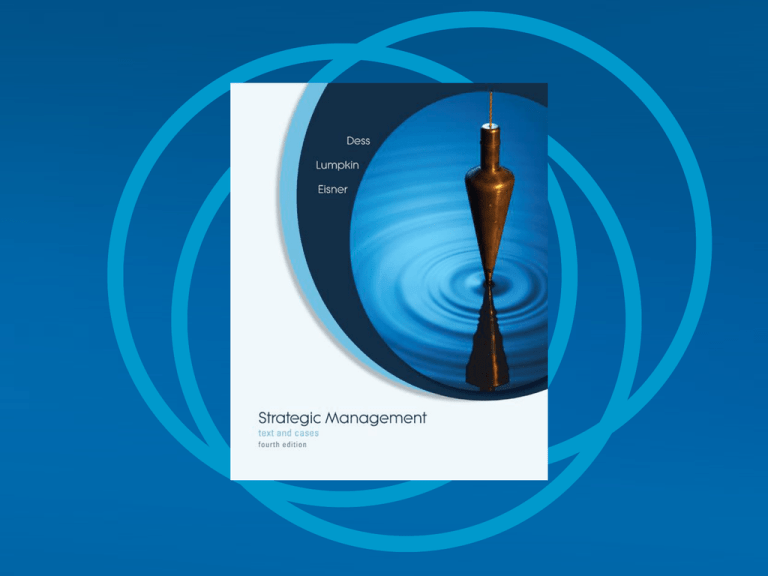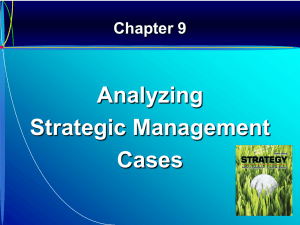
13
Analyzing Strategic
Management Cases
McGraw-Hill/Irwin
Strategic Management: Text and Cases, 4e
Copyright © 2008 The McGraw-Hill Companies, Inc. All rights reserved.
13 - 3
Learning Objectives
•
After reading this chapter, you should have a good
understanding of:
-
-
How strategic case analysis is used to simulate real-world
experiences.
How analyzing strategic management cases can help develop the
ability to differentiate, speculate, and integrate when evaluating
complex business problems.
The steps involved in conducting a strategic management case
analysis.
How conflict-inducing discussion techniques can lead to better
decisions.
How to get the most out of case analysis.
How to use the strategic insights and material from each of the 12
previous chapters in the text to analyze issues posed by strategic
management cases.
13 - 4
Why Analyze Strategic
Management Cases?
• The process of analyzing, decision making, and
implementing strategic actions raises many good
questions
- Why do some firms succeed and others fail?
- Why are some companies higher performers than others?
- What information is needed in the strategic planning
process?
- How do competing values and beliefs affect strategic
decision making?
- What skills and capabilities are needed to implement a
strategy effectively?
13 - 5
Why Analyze Strategic
Management Cases?
• Case analysis
- Simulates the real-world experience
- Forces you to choose among different options
- Set forth a plan of action based on your choices
• Strategic management cases
- Detailed description of a challenging situation faced by an
organization
- Usually includes a chronology of events and extensive
support materials
- Financial statements
- Product lists
- Transcripts of interviews with employees
13 - 6
Skills Developed from Case Analyses
• Differentiate
- Evaluate many different elements of a situation at once
- Differentiating between the factors that are influencing the
situation
- Understanding that problems are often complex and
multilayered
• Dig deep
• Being too quick to accept an easy solution will probably fail
to get to the heart of the problem
13 - 7
Skills Developed from Case Analyses
• Speculate
-
Envision explanation that might not readily be apparent
Imagine different scenarios
Contemplate the outcome of a decision
Deal with uncertainty and incomplete knowledge
• Missing data
• Information may be contradictory
• Speculate about details and consequences that are unknown
13 - 8
Skills Developed from Case Analyses
• Integrate
- Look at the big picture
- Have an organization-wide perspective
- Integrate the information into one set of recommendations
affecting the whole company
• Changes made in one part will affect the others
• Integrate the impact of various decisions and environmental
influences on all parts of the organization
13 - 9
How to Conduct a Case Analysis
• Prepare for a case discussion
-
Do your homework
Investigate
Analyze
Research potential solutions
Gather the advice of others
Become immersed in facts, options, and implications
13 - 10
How to Conduct a Case Analysis
• Put yourself “inside” the case
- Think like an actual participant
• Strategic decision maker
• Board of directors
• Outside consultant
- Try different perspectives
• One of the most challenging is as a business founder or
owner
• Hiring an outside consultant may not be an option
13 - 11
Five Steps for Conducting a Strategic
Management Case Analysis
• Step 1: Become familiar with the material
- Read quickly through the case one time
- Use initial read-through to assess possible links to strategic
concepts
- Read the case again, making notes
- Evaluate application of strategic concepts
- After forming first recommendation, thumb through the
case again to assess consequences of actions you propose
13 - 12
Five Steps for Conducting a Strategic
Management Case Analysis
• Step 2: Identify problems
- Some cases have more than one problem
- Avoid getting hung up on symptoms
- Articulate the problem
• Writing down a problem statement gives you a reference
point when you proceed through case analysis
- Some problems are not apparent until after you do the
analysis
13 - 13
Five Steps for Conducting a Strategic
Management Case Analysis
• Step 3: Conduct strategic analyses
- Determine which strategic issues are involved
- Use strategic tools to conduct the analysis
•
•
•
•
Five Forces analysis
Value chain analysis
Contingency frameworks
Financial analysis
- Test your own assumptions about the case
13 - 14
Financial Ratio Analysis Techniques
Ratio
What It Measures
Short-term
solvency, or
liquidity,
ratios:
Current ratio
Quick ratio
Cash ratio
Ability to use assets to pay off liabilities.
Ability to use liquid assets to pay off liabilities quickly.
Ability to pay off liabilities with cash on hand.
Adapted from Exhibit 13.1 Summary of Financial Ratio Analysis Techniques
13 - 15
Financial Ratio Analysis Techniques
Ratio
What It Measures
Long-term
solvency, or
financial
leverage,
ratios:
Total debt ratio
Debt-equity ratio
Equity multiplier
Times interest
ratio
Cash coverage
ratio
How much of a company’s total assets are financed by debt.
Compares how much a company is financed by debt with how
much is it finance by equity.
How much debt is being used to finance assets.
How well a company has its interest obligations covered.
A company’s ability to generate cash from operations.
Adapted from Exhibit 13.1 Summary of Financial Ratio Analysis Techniques
13 - 16
Financial Ratio Analysis Techniques
Ratio
Asset
utilization, or
turnover,
ratios:
Inventory turnover
Day’s sales in
inventory
Receivables
turnover
Days’ sales in
receivables
Total asset
turnover
Capital intensity
What It Measures
How many times each year a company sells its entire inventory.
How many days on average inventory is on hand before it
is sold.
How frequently each year a company collects on its credit
sales.
How many days on average it takes to collect on credit
sales (average collection period).
How much of sales is generated for every dollar in assets.
The dollar investment in assets needed to generate $1 in sales.
Adapted from Exhibit 13.1 Summary of Financial Ratio Analysis Techniques
13 - 17
Financial Ratio Analysis Techniques
Ratio
Profitability
ratios:
Profit margin
Return on assets
(ROA)
Return on equity
(ROE)
What It Measures
How much profit is generated by every dollar of sales.
How effectively assets are being used to generate a
return.
How effectively amounts invested in the business by its
owners are being used to generate a return.
Market value
ratios:
Price-earnings
ratio
Market-to-book
ratio
How much investors are willing to pay per dollar of current
earnings.
Compares market value of the company's investments to
the cost of those investments
Adapted from Exhibit 13.1 Summary of Financial Ratio Analysis Techniques
13 - 18
Example
• Google Inc. – Selected key financial ratios
Financial Ratio
Company
Industry
Current ratio
11.2
8.9
Quick ratio
11.2
8.9
Debt-equity ratio
0.00
0.02
Return on assets (ROA)
22.3
18.3
Return on equity (ROE)
24.4
20.7
Asset turnover
0.8
0.7
Receivable turnover
10.4
10.9
Source: http://moneycentral.msn.com
13 - 19
Five Steps for Conducting a Strategic
Management Case Analysis
• Step 4: Propose alternative solutions
- Develop a list of options first without judging them
• “Do nothing” is often a reasonable alternative
- Evaluate alternatives
•
•
•
•
•
•
Can the company afford it?
Is the solution likely to evoke a competitive response?
Will employees accept the change?
How will it affect other stakeholders?
How does it fit with the vision, mission, objectives?
Will the culture or values of the company change?
13 - 20
Five Steps for Conducting a Strategic
Management Case Analysis
• Step 5: Make recommendations
-
Make a set of recommendations that your analysis supports
Describe exactly what needs to be done
Explain why this course of action will solve the problem
Include suggestions for how best to implement the proposed
solution
- The solution you propose must solve the problem you
identified
13 - 21
Preparing an Oral Case Presentation
Rule
Description
Organize your
thoughts
Begin by becoming familiar with the material. Compare notes
about key points of the case and share insights among team
members. Make an outline.
Emphasize
strategic
analysis
Purpose of case analysis is to diagnose problems and find
solutions. You may need to unravel the case material as presented
and reconfigure it in a way that can be more effectively analyzed.
Three major categories
• Background/Problem Statement
10-20%
• Strategic Analysis/Options
60-75 %
• Recommendations/Action Plan
10-20%
Emphasis should be on analysis. You may need to reorganize the
material so that the tools of strategic analysis can be applied.
Adapted from Exhibit 13.2 Preparing an Oral Case Presentation
13 - 22
Preparing an Oral Case Presentation
Rule
Description
Be logical and
consistent
Rambling presentations are hard to follow, may confuse the
listener, and fail to evoke a good discussion. Present arguments
and explanations in logical sequence. Support with facts and
appropriate financial analyses. Be sure solutions address the
problems you identified.
Defend your
position
Anticipate what others might disagree with and be prepared to
defend your views in class discussion. Be aware of the choices
you made and implications of your recommendations. Be clear
about your assumptions. Be able to expand on your analysis.
Share
presentation
responsibilities
Strategic management case analyses are often conducted by
teams. Each member should have a clear role in the oral
presentation, preferably a speaking role. Coordinate the
different parts into a logical, smooth-flowing whole.
Adapted from Exhibit 13.2 Preparing an Oral Case Presentation
13 - 23
Example
• Here are five tips to “wow” your audience like Steve
Jobs, co-founder of Apple:
-
Sell the benefit
Practice, Practice, and Practice Some More
Keep It Visual
Exude Passion, Energy, and Enthusiasm
At the end of your presentation add more suspense by
stating “and one more thing..."
Source: Gallo, Carmine. “How to Wow 'Em Like Steve Jobs,” Business Week. April 6, 2006
13 - 24
How to Get the Most from Case Analysis
• Keep an open mind
• Take a stand for what you believe
• Draw on your own personal experience
• Participate and persuade
• Be concise and to the point
• Think out of the box
• Learn from the insights of others
• Apply insights from other case analyses
• Critically analyze your own performance
• Conduct outside research
13 - 25
Preparing a Written Case Analysis
Rule
Description
Be thorough
Many ideas about oral presentations also apply to written case
analysis. However, a written analysis typically has to be more
complete. Write out the problem statement and articulate
assumptions. Support your arguments and reference case
materials and other facts more specifically.
Coordinate
team efforts
Written cases are often prepared by small groups. Within a group
you may disagree about the diagnosis or recommended plan of
action. Healthy disagreement may lead to a richer understanding
of the case, but, before committing your ideas to writing make
sure you coordinate your responses. Don’t prepare a written
analysis that appears contradictory or looks like a patchwork of
disconnected thoughts.
Adapted from Exhibit 13.3 Preparing a Written Case Analysis
13 - 26
Preparing a Written Case Analysis
Rule
Avoid
restating the
obvious
Present
information
graphically
Exercise
quality control
Description
There is no reason to restate the case content. This uses up valuable space
and accomplishes little. Stay focused on key points. Only restate
information that is most central to your analysis.
Tables, graphs, and other exhibits are usually one of the best ways to
present supporting factual material. Financial calculations such as breakeven analysis, sensitivity analysis, or return on investment are best
presented graphically. Even qualitative information such as product lists
or rosters of employees can be summarized and viewed quickly by using
a table or graph.
Use good grammar, avoid misspelling words, and eliminate typos and
other visual distractions. Make your written presentation appear as
professional as possible. Don’t let a poor appearance of your written case
keep the reader from recognizing the importance and quality of your
analysis.
Adapted from Exhibit 13.3 Preparing a Written Case Analysis
13 - 27
Using Conflict-Inducing DecisionMaking Techniques in Case Analysis
Devil’s
Advocacy
Dialectical
Inquiry
Group Think
Use conflict-inducing decision-making techniques to help
prevent groupthink and lead to better decisions.
13 - 28
Question
What are the symptoms of groupthink identified by
Irving Janis? Have experienced any of these in a
group situation? Explain.
13 - 29
Analysis-Decision-Action Cycle
in Case Analysis
1. Analyzing organizational goals and objectives
-
Has the company developed short-term objectives that are
inconsistent with its long-term mission?
Has the company considered all of its stakeholders equally
in making critical decisions?
Is the company faced with an issue that conflicts with one
of its longstanding policies?
13 - 30
Analysis-Decision-Action Cycle
in Case Analysis
2. Analyzing the external environment
-
Does the company follow trends and events in external
environment?
Is the company effectively scanning and monitoring the
competitive environment?
Has the company analyzed the impact of competitive
forces in its industry on profitability?
13 - 31
Analysis-Decision-Action Cycle
in Case Analysis
3. Analyzing the internal environment
-
Does the company know how the various components of
its value chain are adding value to the firm?
Has the company accurately analyzed the source and
vitality of its resources?
Is the company’s financial performance as good as or
better than that of its close competitors?
13 - 32
Analysis-Decision-Action Cycle
in Case Analysis
4. Assessing a firm’s intellectual assets
-
Does the company have underutilized human capital?
Is the company missing opportunities to forge strategic
alliances?
Has the company developed knowledge-management
systems that capture what it learns?
13 - 33
Analysis-Decision-Action Cycle
in Case Analysis
5. Formulating business-level strategies
-
Has the company chosen the correct competitive strategy,
given its industry environment and competitive situation?
Does the company use combination strategies effectively?
Is the company using a strategy that is appropriate for the
industry life cycle in which it is competing?
13 - 34
Analysis-Decision-Action Cycle
in Case Analysis
6. Formulating corporate-level strategies
-
-
Is the company competing in the right businesses, given
the opportunities and threats that are present in the
environment?
Is the corporation managing its portfolio of businesses in a
way that creates synergies among the businesses?
Are the motives of the top corporate executives who are
pushing diversification strategies appropriate?
13 - 35
Question
Corporate strategies address methods for achieving
______ among businesses within a large firm’s
portfolio.
A) synergies
B) competitiveness
C) devil’s advocacy
D) teamwork
13 - 36
Analysis-Decision-Action Cycle
in Case Analysis
7. Formulating international-level strategies
-
Is the company’s entry into an international marketplace
threatened by the actions of local competitors?
Has the company made the appropriate choices between
cost reduction and local adaptation to foreign markets?
Can the company improve its effectiveness by embracing
one international strategy over another?
13 - 37
Analysis-Decision-Action Cycle
in Case Analysis
8. Formulating Internet strategies
-
-
-
Is the company engaged in an ongoing process of opportunity
recognition? If not, how can it enhance its ability to recognize
opportunities?
Do the entrepreneurs who are launching new ventures have
vision, dedication and drive, and a commitment to excellence?
If so, how have these affected the performance and dedication
of other employees involved in the venture?
Have strategic principles been used in the process of
developing strategies to pursue the entrepreneurial opportunity?
If not, how can the venture apply tools such as five-force
analysis and value-chain analysis to improve its competitive
position and performance?
13 - 38
Analysis-Decision-Action Cycle
in Case Analysis
9. Achieving effective strategic control
-
Is the company employing the appropriate informational
control systems?
Does the company have a strong and effective culture?
Has the company implemented control systems that match its
strategies?
10. Creating effective organizational designs
-
Has the company implemented organizational structures that
are suited to the type of business it is in?
Is the company employing boundaryless organizational designs
where appropriate?
Does the company use outsourcing to achieve the best possible
results?
13 - 39
Analysis-Decision-Action Cycle
in Case Analysis
11.Creating a learning organization and an ethical
organization
-
Do company leaders promote excellence as part of the
overall culture?
Is the company committed to being a learning
organization?
Have company leaders exhibited an ethical attitude in their
own behavior?
13 - 40
Analysis-Decision-Action Cycle
in Case Analysis
12.Fostering corporate entrepreneurship
-
Has the company resolved the dilemmas associated with
managing innovation?
Has the company developed autonomous work units that
have the freedom to bring forth new product ideas?
Does the company have an entrepreneurial orientation?









